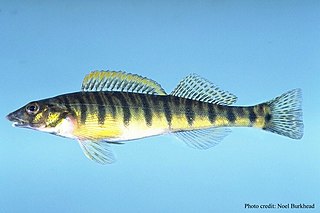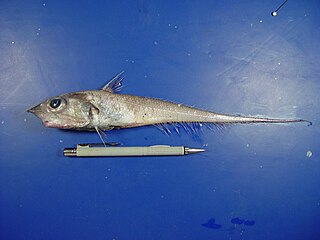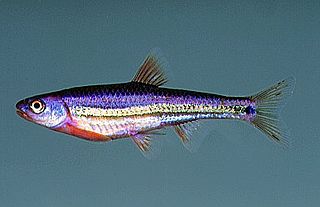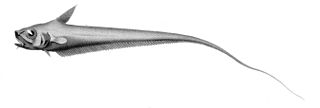
Grenadiers or rattails are generally large, brown to black gadiform marine fish of the subfamily Macrourinae, the largest subfamily of the family Macrouridae. Found at great depths from the Arctic to Antarctic, members of this subfamily are amongst the most abundant of the deep-sea fish.

Etheostoma is a genus of small freshwater fish in the family Percidae native to North America. Most are restricted to the United States, but species are also found in Canada and Mexico. They are commonly known as darters, although the term "darter" is shared by several other genera. Many can produce alarm pheromones that serve to warn nearby fish in case of an attack.

Percina is a genus of small freshwater ray-finned fish, classified within the subfamily Etheostomatinae, part of the family Percidae, which also contains the perches, ruffes and pikeperches from North America. Along with similar fishes in certain other genera, members of Percina are commonly called "darters". More specifically, the genus as a whole is known as roughbelly darters, while certain species of Percina with a pattern of vertical bars on the flanks are called logperches.

A midshipman fish is any species of toadfish belonging to the genus Porichthys. Historically, there have been two common names. Porichthys refers to the well developed pores on the fish, and this led to the common name "Porous Catfish". The other common name, "Midshipman" is based on the pattern of button-like luminous spots (photophores) which resemble the buttons on the uniforms of young naval officers known as Midshipmen.

Fundulus is a genus of ray-finned fishes in the superfamily Funduloidea, family Fundulidae. It belongs to the order of toothcarps (Cyprinodontiformes), and therein the large suborder Cyprinodontoidei. Most of its closest living relatives are egg-laying, with the notable exception of the splitfin livebearers (Goodeidae).

Coelorinchus is a genus of rattail fish.

Coryphaenoides is a genus of rattails which is found in all oceans of the world. They are found in deep waters and C. yaquinae, recorded to 7,012 m (23,005 ft), is the only member in the family known from the hadal zone.

Gadomus is a genus of rattails in the family Bathygadidae.
Bathygadus is a genus of rattails of the family Bathygadidae.

Nezumia is a genus of rattails. The generic name derives from the Japanese 鼠 (nezumi), meaning "mouse".

Hymenocephalus is a genus of rattails.

Ventrifossa is a genus of rattails in the family Macrouridae.

Crenichthys is a genus of fish in the subfamily Empetrichthyinae which is part of the family Goodeidae, the splitfins. This small genus consists of two species which are both endemic to Nevada in the United States. They occur in small populations in isolated warm springs. Fish of this genus are known commonly as springfish.

Notropis is a genus of freshwater fish in the family Cyprinidae. They are known commonly as eastern shiners. They are native to North America, and are the continent's second largest genus.
Macrhybopsis, the blacktail chubs, is a genus of cyprinid fish that are found in North America. There are currently 12 species in this genus.

Limanda is a genus of righteye flounders native to the northern Atlantic and Pacific oceans.
Kuronezumia is a genus of rattails.
Mesovagus is a genus of rattails found in Indian and Pacific Ocean.

Sphagemacrurus is a genus of rattails.
Hymenogadus is a genus of rattails, marine fish.















